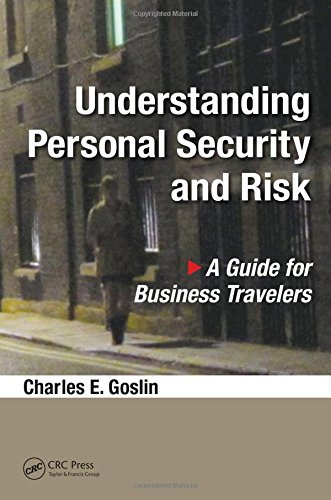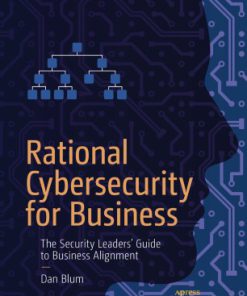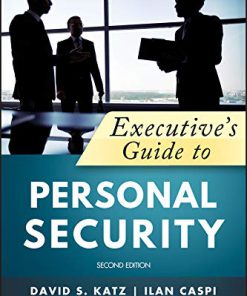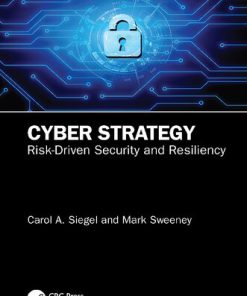Understanding personal security and risk a guide for business travelers 1st Edition by Charles E Goslin 1498765785 9781498765787
$50.00 Original price was: $50.00.$25.00Current price is: $25.00.
Understanding personal security and risk : a guide for business travelers 1st Edition by Charles E Goslin – Ebook PDF Instant Download/DeliveryISBN: 1498765785, 9781498765787
Full download Understanding personal security and risk : a guide for business travelers 1st Edition after payment.

Product details:
ISBN-10 : 1498765785
ISBN-13 : 9781498765787
Author: Charles E Goslin
Uniting broad, time-tested security principles and the author’s 35-plus years of experience with international security, intelligence, and foreign affairs, Understanding Personal Security: A Guide for Business Travelers offers a detailed yet practical framework on which to develop personal security awareness and training programs. As a critical resource for any travelers who may need to make fast, smart judgements in high-risk environments, this book helps readers analyze threats, threat actors, and the common adversarial characteristics, as well as the function of risk as a differentiating principle. This versatile text blends abstract organizing principles with street honed instincts, becoming equally valuable to security managers with previous experience and those corporate or non-profit organizations with employees in developing nations.
Understanding personal security and risk : a guide for business travelers 1st Table of contents:
Chapter 1 Important Personal Security Concepts
Introduction
Concept of Effectiveness
Concepts of Threat, Vulnerability, and Risk
Concept of Time
Committing a Security Plan to Memory
Threat Agents and Threat Actors
Chapter 2 Personal Security Principles
Introduction
Principle of Preparation
Preparing for Contingencies
Developing a Threat Profile: Preparation for Incidents
Guidebooks as a Resource
Geographical Memorization: Preparation for Movement
Physical and Mental Health
Physical Heath: Medical Necessities
Physical Health: Health Insurance
Mental Health: Engineering Peace of Mind: Technical Communication Preparation
Clothing and Appearance Preparation
Documentation
Packing for Mobility and Portability
Limiting the Luggage Load
Spreading Your Risk
Preparing Delay Measure Tools: Throw-Down Wallet
Principle of Detection
Principle of Deterrence
Principle of Delay
Principle of Defense
Reality of Confrontation
Delivering Effective Violence (Fighting)
Protecting Yourself from Blows
Getting Out of Holds
Keep It Simple
Selected Threat Actor Profile: Street Gangsters
References
Endnote
Chapter 3 When Travel Plans Go Sideways
Introduction
Arrival at the Airport
At Arrivals
Arrival Hall: Public Space
On the Road: Checkpoints and Roadblocks
General Guidelines for Roadblocks
Preparation
Communications
Managing Your Team
Approach and Interaction
Police Checkpoints
Police in Conflict Zones
Police in Criminal-Controlled Regions
Military or Paramilitary Checkpoints in Conflict Zone
Standard Military Checkpoint
Paramilitary, Militia, or Flying Checkpoints
Criminal Roadblocks
Selected Threat Actor Profiles: Roadblocks and Military, Insurgents, and Police
Military Roadblocks
Insurgent Roadblocks
Endnotes
Chapter 4 Kidnapping
Introduction
Classifying Types of Kidnap/Abduction Operations
Type 1: Money but No Politics
Type 2: No Money, No Politics
Type 3: Money and Politics
Type 4: Politics, No Money
Tip of the Iceberg: Keeping Kidnap Threat Trends in Perspective
Top Severe Kidnap Threat Countries for 2016
Regional Summary
Latin America
Africa
Asia
International Patterns and Trends in Kidnapping
The Gap between Rich and Poor and Failed States
The Collapse of Communism and the End of the Cold War
A Weak Ethical Environment
Arab “Spring,” Arab “Winter,” and Islamic Extremism
A Closer Look: Kidnap for Ransom
Target Selection Development Phase
Intelligence Gathering Operation
Route Analysis, Snatch Location Selection, and Logistics
Abduction Operation
Abduction Case Study: Victor Cortez
Negotiation
Different Types of Kidnapping Operations
Political Abduction
Express Kidnap
Virtual Kidnap
Tiger Kidnap
Measures to Counter the Kidnap Threat
Preparation Principle: Advance Planning Measures Specific to Kidnap
Detection Principle: Countersurveillance
Principle of Deterrence: Crafting a Low, Unpredictable Profile
Principle of Delay: Slowing Down the Abduction
Principle of Defense: Survival Strategies in Captivity
Recovering from Kidnap
Executive Protection: Key Elements of a Program
Program Development: Step 1—Risk Assessment
Program Development: Step 2—Protection Plan
Program Development: Step 3—Stakeholder Engagement: The Human Factor
Program Development: Step 4—Planning Process Document
Program Development: Step 5—Implementation
Selected Threat Actor Profile: The Mind-Set of a Kidnapper
References
Endnotes
Chapter 5 Patterns of Threat in the Environment
Introduction
Cover of Darkness
Alcohol, Drugs, and the Environment
Broken Windows
Gangs and Gang Activity
Natural Disasters
Civil Disorder and Rioting
References
Endnote
Chapter 6 Hotel and Residential Security
Introduction
Considerations When Choosing a Hotel
Location and Layout Trumps Amenities, Convenience, and Proximity
Realistic Expectations
Hotel Arrival: Deterrence and Delay
Standoff and Perimeter Security
Screening
Arrival to Check-In: Moving from Public to Private Space
Communications: The Need to Know
Room Selection
Moving from Public to Private Space: Front Desk to Room
In the Room
At the Room Entrance
Initial Entry to the Room
While in the Room
In the Event of a Security Incident or a Fire
In and around the Hotel
Residential Security
Residence Selection: Security Preparation and Planning Measures
Perimeter: Security Detection and Delay
Gate Guards: Deterrence, Detection, Delay, and Response
Canines
Exterior Lighting and Decorative Shrubs: Detection and Deterrence
Ground Floor Windows and Doors and Exterior: Security Delay Measures
Inside the Residence: Layering Your Defenses
Detection
Deterrence
Delay: Importance of Establishing a Safe Room
Respond
Selected Threat Actor Profiles: Pickpockets, Thieves, and the World’s Oldest Profession
Endnotes
Chapter 7 Cybersecurity on the Road
Introduction
Darkhotel Threat
Foreign Intelligence Service Threat
The Honey Trap Threat
Technical Threat
Vulnerabilities
Personal Cybersecurity Program for the Business Traveler
Established Secure Baseline of Information Security
Preparation
Detection
Delay
Defense
Response
Identity Theft Abroad
References
Endnotes
Chapter 8 Shopping Malls, Sports Stadiums, Theaters, etc.Soft Targets
Introduction
Preparation
Detection
Considerations About the Threat
Response Countermeasure 1: Active Shooters
Run
Chokepoints and Routes
Hide
Fight
Recovery
Response Countermeasure 2: Suicide Bomber
Preattack Phase
Detonation Phase
Postdetonation Phase
Selected Threat Actor Profiles: The Jihadist Suicide Bomber
References
Endnote
Chapter 9 Risk Assessment for Personal Security
Introduction
Step 1: Identify Assets and Impact of Loss
Identify Undesirable Events and Anticipated Impacts
Value/Prioritize Assets Based on Consequence of Loss
Impact on Business or Mission Function
Impact on Health (Sickness, Injury, and Death)
Impact on Reputation
Impact on Recoverability
Step 2: Identify and Characterize the Threat to Specific Assets
Identify Threat Categories and Potential Adversaries
Assess Degree of Threat
Intent and Motivation
Skill and Workforce Capability of the Adversary
Determine the Logistic Capability of the Adversary
Determine Frequency of Threat-Related Incidents Based on Historical Data
Determine the Favorability of the Operational Environment
Step 3: Identify and Characterize Vulnerabilities
Identify Vulnerability Vectors with Public Knowledge (Recurring, Nonrecurring, and Time)
Predictability (Itinerary, Movement, and Accommodation)
Physical Protection
Accessibility
Proximity (Collateral Damage Potential)
Step 4: Assess Risks and Determine Priorities for You and Your Team’s Protection
Estimate the Degree of Impact Relative to Yourself or Your Team Members
Estimate the Likelihood of Attack by a Potential Adversary
Estimate the Likelihood That a Specific Vulnerability Will Be Exploited
Determine the Relative Degree of Risk
Step 5: Identify Unacceptable Risks and Determine Risk Mitigation Priorities
Identify the Benefits and Costs of the Countermeasures
Identify the Cost of the Countermeasures
Reference
Endnote
Chapter 10 Personal Security and TransportationSecuring Your Movement
Introduction
By Foot
Ground Transportation: Vehicle and Rail
Bicycle
General Bike-Locking Principles
How to Lock the Bike
Motorbike Security
Rickshaws
Taxis
Buses
Trains
Rental Car and Driving
Safety and Security Risk Considerations
Air Transportation
Prepacking for Security and Safety
At Security Screening
In the Terminal
On the Plane
Emergency Situations
References
Endnotes
Chapter 11 Managing Your Team’s Personal Security
Introduction
Authority
Communications
The Team Briefing
On the Ground
Roadblock Protocol
At the Hotel
Managing Crisis Situations
Principle of Planning
Loss of Mobility
Loss of Command and Control: Criticality of Communications
Loss of Security and Safety
Postcrisis Considerations
People also search for Understanding personal security and risk : a guide for business travelers 1st:
understanding cybersecurity risk management
understanding information security
understand security controls
understand security risk
understanding cyber security
Tags: Understanding, personal security, risk, guide, business travelers, Charles Goslin
You may also like…
Computers
Rational Cybersecurity for Business: The Security Leaders’ Guide to Business Alignment Dan Blum
Uncategorized
Business & Economics - Management & Leadership
Strategic Security Management: A Risk Assessment Guide for Decision Makers 2nd Edition Karim Vellani
Computers - Computer Science
Education Studies & Teaching - School Education & Teaching
Understanding Islam A Guide For Teachers 1st Edition by Imran Mogra ISBN 1526438585 978-1526438584
Business & Economics - Management & Leadership
Business & Economics - Management & Leadership
Borderless Leadership: Global Skills for Personal and Business Success Zlatica Kraljevic












